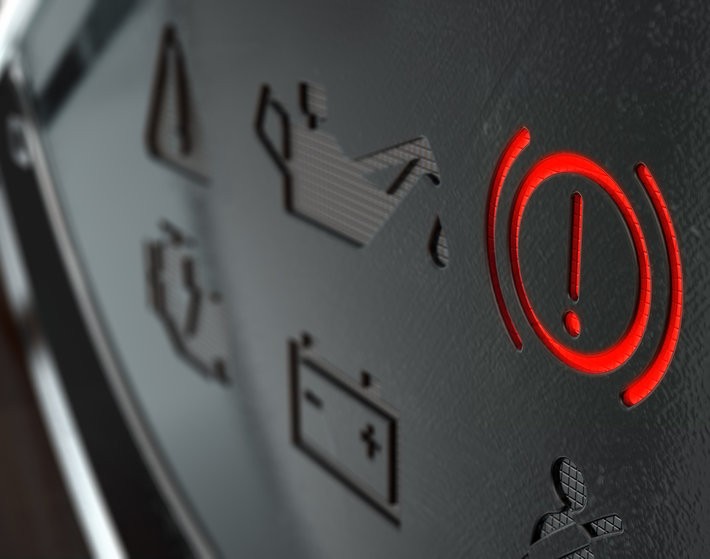The most important dashboard signs every driver MUST know

Every time you start your vehicle or turn your ignition key to the on position, there are illuminated symbols on the dashboard that perform a self-test to let you know the bulbs are working. While these lights usually go off right away and are soon forgotten, there will be times when one or more of these lights will stay on and inform you of a problem, something you need to be aware of, or that a specific system has been activated.
Dashboard lights are generally color-coded. As a rule of thumb, there are three classes of dashboard indicator lights easily distinguished by color. The usual colors are red, yellow, and green. These colors are similar to traffic signal lights in color and meaning.
Red indicates a potential safety issue or serious problem, and it is possible you should stop driving the vehicle immediately. A red dashboard light may also indicate an important reminder that needs immediate attention.
Yellow (sometimes orange) dashboard lights usually mean something needs to be repaired or serviced soon and to operate with caution.
Green (sometimes blue) dashboard lights usually indicate a system is on or is operating, and the light is giving you a visual cue.
Additionally, it is important to know a flashing dashboard warning light is used to inform the driver of a state of urgency related to the system referenced by the light.
BRAKE SYSTEM
The brake system light could mean the brake fluid level is low, the parking brake is on or there is an issue with the anti-lock braking system (ABS). Perform a quick visual inspection to see if the parking brake is engaged and inspect the brake fluid level to ensure it is full. This warning light could be serious if it is related to a loss of brake fluid due to a leak.

ENGINE COOLANT TEMPERATURE
The engine coolant temperature warning light is serious and indicates your engine is too hot, or your coolant level is low or the vehicle may have a faulty coolant temperature sensor. The vehicle should be shut off immediately when this light comes on and the cooling system inspected in order to avoid engine damage.
CHECK ENGINE LIGHT
The check engine light indicates the engine computer has set a diagnostic trouble code (DTC) in the engine management system and is usually related to emission control systems or running concerns. The vehicle still may appear to be running normally. A check engine light doesn’t mean you have to immediately pull the car to the side of the road, but it should be inspected as soon as possible. A flashing check engine light requires immediate attention.
ENGINE OIL PRESSURE WARNING
The engine oil pressure warning light comes on when the oil pressure sensor detects low oil pressure. This could indicate a low engine oil level, a loss of engine oil pressure or a faulty engine oil pressure sensor. The engine oil level and pressure should be checked immediately. Low oil level or low oil pressure will cause serious damage to the internally lubricated parts of the engine.
BATTERY/CHARGING ALERT
The battery/charging light indicates the battery voltage level is below normal, and the charging system is not functioning properly. The alternator belt should be inspected, the battery terminals and connections inspected and the alternator should be tested. This light being on will likely result in your vehicle losing all electrical power very soon.
ANTI-LOCK BRAKE SYSTEM
The anti-lock brake system light indicates there is a fault with the ABS system. This will not result in losing your brakes, but additional ABS safety features have been switched off when this warning light is on.

WINDSHIELD WASHER FLUID LEVEL
The windshield washer fluid level light indicates the washer fluid level is low.

TPMS (TIRE PRESSURE MONITORING SYSTEM)
The TPMS light indicates that one or more tires has low air pressure or there could be an issue with a sensor. The tire pressure should be inspected in all of the tires and adjusted to specifications. Some vehicles will allow a manual reset of the TPMS warning light by driving while others may require you to bring the vehicle to a professional service technician to recalibrate it.
AIRBAG INDICATOR
The airbag light indicates there is a problem with one or more of the airbags or the airbag system.
SEATBELT REMINDER
The seatbelt reminder light simply reminds you to buckle your seatbelt and be safe!
LOW FUEL INDICATOR
The low fuel light warns you the vehicle is running low on fuel. The amount of fuel remaining in the fuel tank when the low fuel light comes on varies from vehicle to vehicle, but generally there is between one and two gallons of fuel left.

AUTOMATIC SHIFT LOCK or ENGINE START
This indicator light is informational and means you need to engage the brake to either shift the vehicle out of park or start the car.

DOOR AJAR
The door ajar indicator light comes on when one of the doors is not shut or if one of the door jamb switches is malfunctioning.

These are some of the more common warning or informational lights on your dashboard that may illuminate. The truly serious ones referenced above include the brake system, coolant temperature, engine oil pressure and battery/charging alert indicators. All of these warning lights could result in serious damage, a stranded vehicle or safety issues. It is very important to monitor your dashboard and respond appropriately when one of the dashboard lights comes on.
Your dashboard is designed to keep you informed about the health of your vehicle and provide information about systems in use. If you are unsure what a dashboard indicator light means, use the owner’s manual for your vehicle to look it up.
